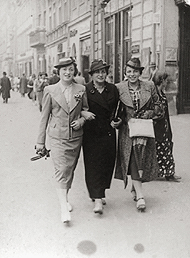![]()
Departments
![]()

|
Week of 10 September 1999 |
Vol. III, No. 5 |
Feature Article
Down from the attics, up from the ashes
Murdered and scattered, the Jews of Poland are recollected in photographs
By Eric McHenry
Zahava Bromberg managed not only to survive Auschwitz but to keep and conceal a tiny photograph of her mother.
"I carried [it] through two selections by Dr. Mengele . . ." she writes. "Once, I held it in my mouth, the second time, I had it taped with a bandage to the bottom of my foot. I was 14 years old."
Even then, the picture was a memorial: her mother, Debora Goldstein-Rosen, and the rest of her immediate family had already been murdered in the Plaszow concentration camp. Half a century later, the countenance is still discernible. Asymmetrical, creased, and faded, the photograph continues to deliver its silent eulogy.
|
|
|
"Her name was Taube, or Tauber, or maybe Tauberg. . . . Regina was [my mother's] very good friend from a home-tailoring course . . . She had seven children." The photo was taken between 1934 and 1937. |
Prior to Hitler's 1939 invasion, Poland was home to the world's largest Jewish population. "There were more than three million Jews in Poland before the Holocaust," says Rabbi Joseph Polak, director of B'nai B'rith Hillel House at BU and head of the exhibition committee. "Today there may be 2,000. Warsaw had 25 Yiddish newspapers publishing in 1935, weeklies and dailies, and now there are none. These photographs are about a community that was destroyed because of hatred and because of apathy."
And I Still See Their Faces is the flagship project of the Warsaw-based Shalom Foundation. Established in 1988 by singer-actress Golda Tencer, it celebrates Polish-Jewish heritage through the creation of memorials, books, exhibitions, and cultural events.
In 1994, Tencer issued a call to the people of Poland, a public request for photos entrusted to friends and neighbors by Jewish families when their deportation was imminent. More than 8,000 came in from throughout Poland and other parts of the world. The foundation created an archive and culled it for a representative sampling, which became And I Still See Their Faces.
Shortly after its American debut two years ago in Los Angeles, Lilka Elbaum, a high school friend of Tencer's now living in Boston, began a campaign to give the exhibition a venue at a regional university. She put together and circulated a portfolio of information, then started recruiting benefactors. After a few false starts, she acquired the support of several prominent Bostonians with Polish, Jewish, or Polish-Jewish ancestry, including business consultant Michael Hammer, and later, media mogul Stephen Mindich (SFA'65, COM'67). When a friend put one of Elbaum's information packets in the hands of Rabbi Polak at a BU event, the show found a champion with a university affiliation.
And I Still See Their Faces is uniquely compelling, Polak says, because its subjects are humanized, rather than dehumanized. Except for a handful of post-invasion photographs, there are no signs of the coming catastrophe. Each picture presents full and forward-moving life, but with a harrowing subtext: those pictured do not know how little time they have left.
"The Shalom Foundation has selected the photos for this show very cleverly," Polak says. "These are scenes of throbbing life, and they're so close to our own time. The people in them are doing things that you and I would do."
"The old stereotype of the Eastern European Jew was somebody stooped, extremely religious -- a caricature," adds Elbaum, who is president of the American Association for Polish-Jewish Studies. "This exhibition shows the tremendous diversity of Polish-Jewish culture before the war."
|
|
|
Chaja Tendler from Skala (right)
with her friends, Kraków, 1935.
|
The exhibition features enlarged, computer-enhanced reproductions of the photographs, along with some original prints and other artifacts received by the Shalom Foundation. Letters accompanied many of the materials submitted, and each picture has a legend detailing what curators know about its subjects.
Polak, himself a Holocaust survivor, points to one photo he finds especially touching: three women are walking arm-in-arm down a bustling commercial street. In addition to broad smiles, they wear brooches, small hats, striking patterns.
"I'm very taken by this photograph," he says. "My mother dressed that way. I have pictures of her. This was life in the '30s and '40s -- a lot of fashion, a lot of energy, and a lot of happiness."
And I Still See Their Faces: The Vanished World of Polish Jewry, a program of Boston University Hillel House in cooperation with the Shalom Foundation, Facing History Ourselves, and Boston University through the Jewish Cultural Endowment, can be viewed through October 6 at 808 Commonwealth Ave. Elie Wiesel, Nobel laureate and Andrew W. Mellon Professor in the Humanities at BU, will open the exhibition at a gala event to be held Monday, September 13, from 7 to 9 p.m. Tickets are required for admission. For more information, call 617-353-1105.

